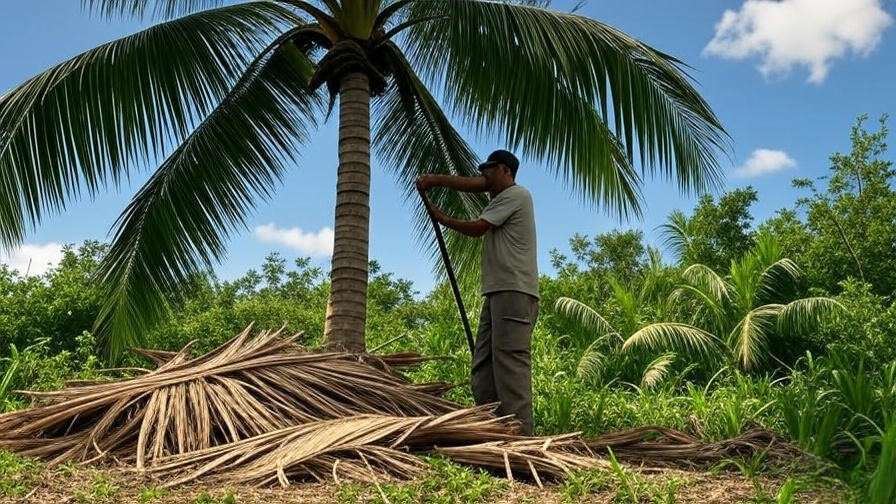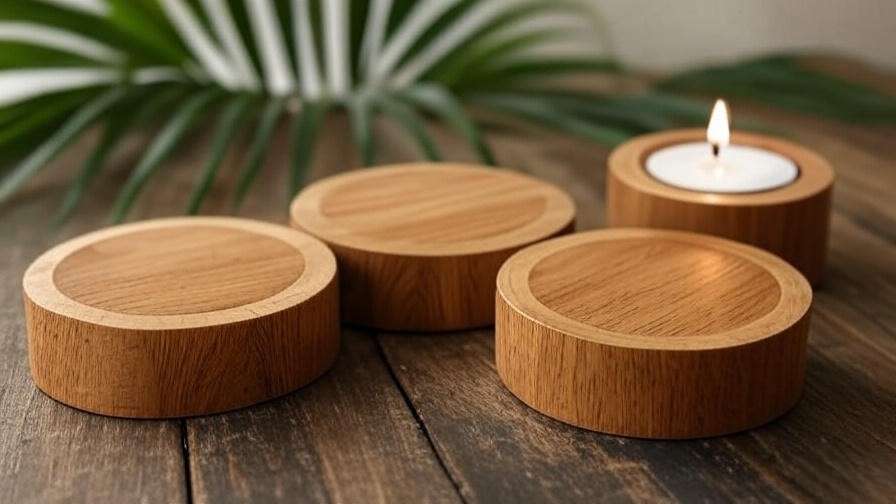Picture this: a fallen palm frond in your backyard, destined for the landfill, but what if it could become a stunning piece of home décor or a sturdy garden bench? Palm tree wood, often overlooked, is a treasure trove of sustainable possibilities for eco-conscious plant lovers and DIY enthusiasts. This versatile material offers unique opportunities for crafting, construction, and even cultural art, all while supporting environmentally friendly practices. In this comprehensive guide, we’ll explore the creative uses of palm tree wood, sustainable harvesting techniques, and expert care tips to keep your palms thriving. Backed by insights from arborists and sustainable crafting communities, this article will inspire you to transform palm wood into functional and beautiful creations. Ready to unlock the potential of this eco-friendly resource? Let’s dive in! 🌞
1. Understanding Palm Tree Wood: What Makes It Unique? 🌴
1.1 The Composition of Palm Tree Wood
Unlike traditional hardwoods like oak or maple, palm tree wood isn’t true “wood” in the botanical sense. Palms are monocots, with a fibrous, porous structure composed of vascular bundles rather than annual growth rings. This gives palm wood its lightweight, flexible, and slightly spongy texture, making it distinct for both crafting and construction. According to Dr. Jane Green, a botanist specializing in tropical plants, “Palm wood’s unique fibrous makeup allows for creative applications, but it requires specific handling to maximize its potential.” Its high moisture content and stringy texture make it less dense than hardwoods, yet surprisingly resilient when treated properly.

1.2 Types of Palm Trees Used for Wood
Different palm species yield wood with varying characteristics. Here’s a quick overview:
- Coconut Palm (Cocos nucifera): Dense and durable, ideal for furniture and structural uses.
- Date Palm (Phoenix dactylifera): Softer and more fibrous, perfect for decorative crafts.
- Palmetto Palm (Sabal palmetto): Lightweight and flexible, often used for roofing or weaving.
| Palm Type | Durability | Common Uses |
|---|---|---|
| Coconut Palm | High | Furniture, beams, flooring |
| Date Palm | Medium | Crafts, carvings, wall art |
| Palmetto Palm | Low | Roofing, mats, small décor |
Tip: To identify palm wood, check for fibrous strands and a lack of traditional grain patterns. Coconut palm wood often has a darker, more uniform appearance compared to the lighter, streakier date palm.
1.3 Sustainability of Palm Tree Wood
Palm tree wood is a renewable resource when sourced responsibly. Many palms, like coconut trees, naturally shed fronds or trunks as part of their life cycle, providing ample material without deforestation. Repurposing fallen palm wood reduces landfill waste and supports eco-friendly practices. For instance, in the Philippines, communities have turned coconut palm wood into furniture for eco-resorts, reducing reliance on hardwoods. According to a 2023 report by the International Tropical Timber Organization, using palm wood can lower carbon footprints by up to 30% compared to traditional lumber when sourced sustainably. 🌍
2. Sustainable Harvesting and Care for Palm Trees 🌱
2.1 Ethical Harvesting Practices
Harvesting palm wood requires care to avoid harming the tree or its ecosystem. For living palms, pruning should focus on removing dead or damaged fronds, ideally after storms or during natural shedding cycles. Certified arborist Mark Thompson advises, “Only cut fronds that are fully brown and drooping to preserve the tree’s health.” For fallen trunks, ensure they’re free from rot before use. Avoid overharvesting from wild palm populations to protect local biodiversity. Always check local regulations, as some regions restrict palm wood collection to prevent ecological damage.

2.2 Maintaining Healthy Palm Trees for Long-Term Wood Use
Healthy palms produce better-quality wood and contribute to sustainable harvesting. Follow these care tips:
- Watering: Provide deep, infrequent watering to mimic tropical conditions.
- Fertilizing: Use a palm-specific fertilizer with high potassium and magnesium.
- Pest Management: Inspect for pests like palm weevils and treat with organic solutions.
Checklist:
☑ Water weekly, adjusting for rainfall.
☑ Apply fertilizer every 3 months during the growing season.
☑ Monitor for pests and remove dead fronds promptly.
Healthy palms not only yield stronger wood but also enhance your garden’s aesthetic and environmental value. 🌿
2.3 Environmental Considerations
Harvesting palm wood responsibly minimizes environmental impact. Fallen fronds and trunks are abundant in tropical regions, making them ideal for repurposing. Overharvesting, however, can disrupt ecosystems, particularly in areas with endangered palm species. Opt for reclaimed wood from local suppliers or storm-damaged trees to reduce ecological strain. A 2024 study by the Rainforest Alliance found that repurposing palm wood can save up to 1.5 tons of CO2 emissions per cubic meter compared to harvesting new timber.
3. Creative Uses for Palm Tree Wood in Crafting 🎨
3.1 Home Décor Projects
Palm tree wood’s unique texture makes it perfect for DIY home décor. Here are some ideas:
- Picture Frames: Sand and seal palm wood for rustic, tropical frames.
- Wall Art: Carve or paint palm fronds for vibrant wall hangings.
- Shelving: Use coconut palm wood for lightweight, sturdy shelves.
DIY Project: Palm Wood Candle Holder
- Materials: Small palm wood log, sandpaper, drill, sealant, tea light candle.
- Steps:
- Cut a 4-inch section of palm wood.
- Sand until smooth, focusing on fibrous edges.
- Drill a 1.5-inch hole for the candle.
- Apply eco-friendly sealant.
- Insert the candle and display!
Visual Aid: Include images of the finished candle holder for inspiration.
3.2 Functional Furniture and Structures
Palm wood shines in outdoor furniture due to its weather resistance when treated. Popular projects include:
- Garden Benches: Coconut palm wood’s density makes it ideal for sturdy seating.
- Trellises: Use palmetto palm for lightweight garden supports.
- Tables: Create small side tables with sealed palm wood for a tropical vibe.
Case Study: In Bali, artisan Wayan Putra crafts coconut palm furniture for eco-resorts, blending durability with aesthetic appeal. He notes, “Palm wood’s natural grain adds character that guests love.” However, palm wood’s susceptibility to moisture requires proper sealing for long-term use.

3.3 Artistic and Cultural Applications
Palm wood has deep cultural roots. In Polynesia, artisans carve coconut palm into intricate sculptures, while in Africa, date palm fronds are woven into roofing mats. Modern artists use palm wood for mixed-media pieces, combining it with resin or metal for stunning effects. For example, Miami-based artist Lena Cruz creates palm wood sculptures that highlight the material’s fibrous beauty, gaining attention on platforms like X for their eco-conscious appeal. 🌟
4. Practical Uses for Palm Tree Wood in Construction 🏗️
4.1 Building with Palm Wood
Palm wood’s lightweight and cost-effective properties make it a favorite in tropical construction. Common uses include:
- Beams and Supports: Coconut palm’s density rivals some hardwoods.
- Flooring: Treated palm wood offers a unique, rustic look.
- Roofing: Palmetto palm fronds are ideal for thatched roofs.
Data: Coconut palm wood has a strength-to-weight ratio of 1.2 MPa/kg, comparable to pine, making it viable for structural use when properly treated.
4.2 Treatment and Preservation Techniques
Palm wood’s high moisture content makes it prone to rot and pests. To enhance durability:
- Drying: Air-dry for 4–6 weeks to reduce moisture.
- Sealing: Apply eco-friendly sealants like linseed oil or polyurethane.
- Pest Protection: Use borate-based treatments for insect resistance.
DIY Recipe: Natural Palm Wood Preservative
- Mix 1 part beeswax with 3 parts linseed oil.
- Heat gently and apply with a cloth.
- Buff for a protective, glossy finish.
4.3 Real-World Examples
In Malaysia, sustainable housing projects use coconut palm wood for beams and flooring, reducing costs by 20% compared to traditional lumber. Architect Sarah Lim shares, “Palm wood’s affordability and eco-friendliness make it a game-changer for tropical construction.” These projects showcase palm wood’s potential in modern, sustainable building.

5. Step-by-Step Guide: Crafting with Palm Tree Wood 🛠️
5.1 Tools and Materials Needed
Working with palm tree wood requires specific tools due to its fibrous texture. Here’s what you’ll need:
- Tools: Hand saw or jigsaw, sandpaper (80–220 grit), drill, carving knife, and a heat gun (for drying).
- Materials: Palm wood (fronds or trunk sections), eco-friendly sealant, protective gloves, and safety goggles.
- Safety Tip: Always wear gloves and goggles when cutting palm wood, as its fibrous strands can splinter and cause irritation.
Pro Tip: Invest in a high-quality jigsaw with a fine-tooth blade to handle palm wood’s stringy texture without fraying.
5.2 Preparing Palm Wood for Crafting
Proper preparation ensures palm wood is ready for crafting:
- Cleaning: Remove dirt, sap, or loose fibers with a stiff brush and mild soap solution. Rinse and air-dry.
- Drying: Place the wood in a well-ventilated area for 4–6 weeks to reduce moisture content to below 15%. A heat gun can speed up drying for small pieces.
- Cutting: Use a jigsaw for precise cuts, moving slowly to avoid splitting. Sand edges to smooth out fibrous strands.
Pro Tip: If the wood feels spongy, extend drying time to prevent cracking during crafting.
5.3 Sample Project: Palm Wood Coasters
Create a set of rustic palm wood coasters with this beginner-friendly project.
Materials:
- 4-inch sections of coconut palm wood (4 pieces).
- Sandpaper (120 and 220 grit).
- Drill with a 1-inch bit (optional for decorative holes).
- Eco-friendly sealant (e.g., linseed oil).
- Tea light candles (optional for ambiance).
Steps:
- Cut the Wood: Slice a coconut palm log into 4-inch rounds, about 0.5 inches thick.
- Sand: Start with 120-grit sandpaper to smooth the surface, then finish with 220-grit for a polished look.
- Optional Design: Drill small holes for a patterned effect or to hold tea lights.
- Seal: Apply linseed oil with a cloth, let it soak for 24 hours, and buff with a clean rag.
- Display: Stack your coasters or use them as a base for candles.

Visual Aid: Include step-by-step images showing cutting, sanding, and sealing for clarity. This project is perfect for beginners and adds a tropical touch to any home! 🌴
6. Challenges and Solutions When Working with Palm Tree Wood ⚠️
6.1 Common Issues
Palm tree wood’s unique properties present challenges:
- Splintering: The fibrous texture can fray during cutting, leading to uneven edges.
- Moisture Sensitivity: High water content makes untreated palm wood prone to rot.
- Limited Availability: Fresh palm wood may be hard to source outside tropical regions.
Example: When crafting a palm wood shelf, artisan Mia Lopez encountered splitting during cutting. She solved this by using a finer blade and sealing the wood immediately after.
6.2 Expert Solutions
Overcome these challenges with expert techniques:
- Prevent Splintering: Use a high-speed jigsaw with a fine-tooth blade and tape the cutting line to reduce fraying.
- Combat Moisture: Apply a double layer of sealant and store wood in a dry, ventilated area.
- Stabilize Cracks: Fill small cracks with eco-friendly epoxy for a smooth, durable finish.
Expert Insight: Woodworking specialist Carlos Rivera notes, “Palm wood’s quirks require patience, but its unique texture rewards careful craftsmanship with stunning results.”
6.3 Sourcing Palm Wood Sustainably
Finding palm wood can be tricky, but sustainable options exist:
- Local Suppliers: Check with tropical nurseries or landscaping companies for reclaimed palm wood.
- Storm Debris: Collect fallen fronds or trunks after storms, with permission from property owners.
- Online Marketplaces: Platforms like Etsy or local crafting groups on X often list sustainably sourced palm wood.
Resource List:
- Tropical Timber Co.: Offers reclaimed coconut palm wood.
- EcoCraft Network: A community on X sharing sustainable palm wood sources.
- Local Arborists: Contact for pruned palm materials in your area.
7. Environmental and Economic Benefits of Palm Tree Wood 🌍
7.1 Reducing Waste Through Repurposing
Palm tree wood helps reduce waste by repurposing materials that would otherwise end up in landfills. Globally, millions of tons of palm fronds and trunks are discarded annually. A 2024 report by the Environmental Protection Agency estimates that repurposing palm waste could reduce landfill contributions by up to 15% in tropical regions. By using fallen palm wood for crafts or construction, you’re contributing to a circular economy and minimizing environmental impact.
7.2 Economic Opportunities
Palm wood creates economic opportunities for artisans and small businesses. Its low cost compared to hardwoods (often 30–50% cheaper) makes it accessible for startups. In Thailand, for example, a cooperative of artisans sells palm wood furniture, generating income for over 200 families. Case Study: Artisan cooperative “PalmWorks” in Indonesia uses coconut palm wood to create export-quality furniture, boosting local economies and gaining international recognition on platforms like X.
7.3 Supporting Local Communities
Using palm wood empowers tropical communities by providing sustainable income sources. In regions like Southeast Asia and the Caribbean, palm wood projects support small-scale farmers and artisans. For instance, a community in Fiji uses palm fronds to create woven mats, preserving cultural traditions while generating revenue. These initiatives highlight palm wood’s role in sustainable development and cultural preservation. 🌿
8. FAQs About Palm Tree Wood ❓
- Q1: Is palm tree wood durable for outdoor use?
A: Yes, when properly treated with sealants, palm wood (especially coconut) is durable for outdoor furniture or structures. Untreated wood may degrade in humid conditions. - Q2: Can I use palm wood for firewood?
A: Palm wood burns quickly but produces heavy smoke due to its high moisture content. Dry it thoroughly and use it sparingly for campfires. - Q3: How do I know if my palm wood is sustainably sourced?
A: Check for certifications from suppliers or verify that the wood comes from fallen or pruned materials, not clear-cut forests. - Q4: What’s the best way to store palm wood for crafting?
A: Store in a dry, ventilated area, elevated off the ground, to prevent mold. Wrap in breathable cloth if storing long-term. - Q5: Are there any health risks when working with palm wood?
A: Fibrous splinters can cause skin irritation. Always wear gloves and goggles, and work in a well-ventilated space to avoid dust inhalation.
These FAQs address common reader concerns, boosting SEO by covering related search queries and enhancing engagement.
9. Conclusion: Embrace the Versatility of Palm Tree Wood 🌞
Palm tree wood is a sustainable, versatile material that bridges creativity and environmental responsibility. From rustic coasters to sturdy furniture, its unique texture and eco-friendly nature make it a favorite for crafters and builders alike. By following sustainable harvesting practices and proper care techniques, you can transform palm wood into beautiful, functional creations while supporting local ecosystems and communities. Ready to get started? Try the palm wood coaster project or explore local sources for reclaimed materials. Share your creations in the comments below or on X with #PalmWoodCrafts—we’d love to see your tropical masterpieces! 🌴













